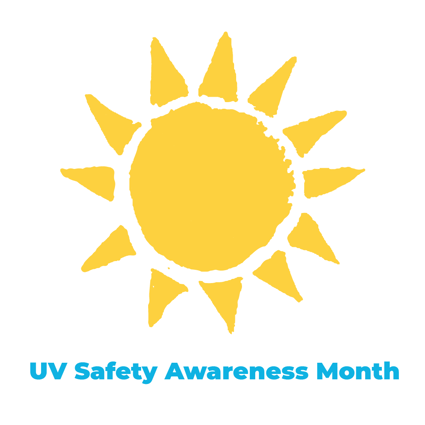July is Ultraviolet Safety Awareness Month.
With the gorgeous long days of summer, everyone wants to be outside. Whether that’s on a boat, in the park, in the backyard, or by the pool — outdoors is the place to be for summer. But with outside time comes the dangers of damage from UV rays.
Every hour, more than two people die of skin cancer in the U.S.; more people are diagnosed with skin cancer annually than all other cancers combined. That’s why it’s important to remind your employees to slather on the sunblock, cover up, and enjoy the sun’s rays responsibly as we head into the hottest part of the year.
Read on to learn useful tips for keeping the sun’s most damaging rays away.
What is UV Light Anyway?
UV light stands for ultraviolet light. These are shorter wavelengths than visible light and are invisible to the human eye. These invisible rays are part of the energy that radiates from the sun. When it gets to Earth, it’s known as UVA or UVB. The UVB rays are the ones that cause skin cancer in humans.
UV Safety Awareness Tips to Remember This Summer
Ready for some fun in the sun?
Before you head out to enjoy your favorite outdoor summertime activities, keep these tips in mind for avoiding direct sun exposure and UV rays. In doing so, you can reduce your risk of issues like sunburn, overheating, heat stroke, and sun poisoning, which often feels similar to the flu.
With a little caution and lots of sunblock, enjoy your day out in the rays!
Check the UV Index First
If your summer days are filled with plenty of outdoor activities, be sure to check the UV Index Search before heading out. This predicts the intensity of UV rays on a 1-11+ scale. The higher the number, the stronger the rays, and the more precautions should be taken.
Slather on SPF
At a minimum, aim to use an SPF 15 or higher. The Skin Cancer Foundation reported this reduces the risk of squamous cell carcinoma by about 40 percent. How much should you use for your whole body? Up to 1.5 ounces — or, the equivalent of a full shot glass — equally spread over your body. Don’t forget the tops of your feet, ears, and your hairline!
Stay Inside When The Sun is Strongest
Keeping out of the sun during peak hours is a good idea — not just to avoid heat illnesses — but also to keep out of the sun’s strongest rays of the day. The University of Iowa Hospitals & Clinics states, “A useful rule of thumb is if your shadow is longer than you are tall there is less danger from the damaging effects of UV rays.” This usually means before 10 a.m. and after 4 p.m.
RELATED: Beating the Heat: How to Stay Safe in Extreme Heat This Summer
Wear Sunglasses
Sunglasses aren’t just for conveniently keeping the sun out of your eyes. UV rays can damage the skin around and in your eyes, including potentially burning the cornea. UV light may also raise your risk of developing cataracts, too, so wearing sunglasses can reduce the risk.
Water Doesn’t Protect You From the Sun’s Rays
If you’re splashing in the pool, beach, or elsewhere, be sure to reapply your sunblock upon exiting. UV rays are powerful enough to reach through the water. In fact, three feet of water blocks just 20% of UV rays! The water also reflects the rays back onto light-colored surfaces and may double the number of harmful rays that hit your skin.
Keep Away From Tanning Beds
If you’re tempted to hit the tanning beds for a little more bronze look before you hit the outdoors this summer, the UV risk is still there. Each year, more than 419,000 cases of skin cancer are tied to indoor tanning, states the Skin Cancer Foundation. Still want to get that glowy tan? Opt for a spray-on tanner or self-bronzer for the same sun-kissed look without the risk of skin cancer.
Get Screened
This summer, make sure to take a trip to the dermatologist for an annual full-body skin scan. They’ll look for any damaged skin and moles to ensure all looks normal. If not, they can take a biopsy of the skin (a quick, relatively painless process) to send off to a lab to ensure all is well.
Play it Safe in the Summer Sun
For much of the United States, the summer months mean a high UV index value and stronger rays. These damaging rays can cause permanent damage to your skin and eyes, so taking the extra time to check information like the heat index is worth it before heading outdoors.
A few other tips to enjoy the sun safely:
- Wear a wide-brimmed hat
- Bring an umbrella or sit under a tree
- Wear protective, lightweight clothing
- Keep plenty of sunscreen on hand
Here’s to enjoying that golden sun while it’s here for the summer!



